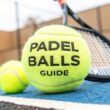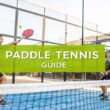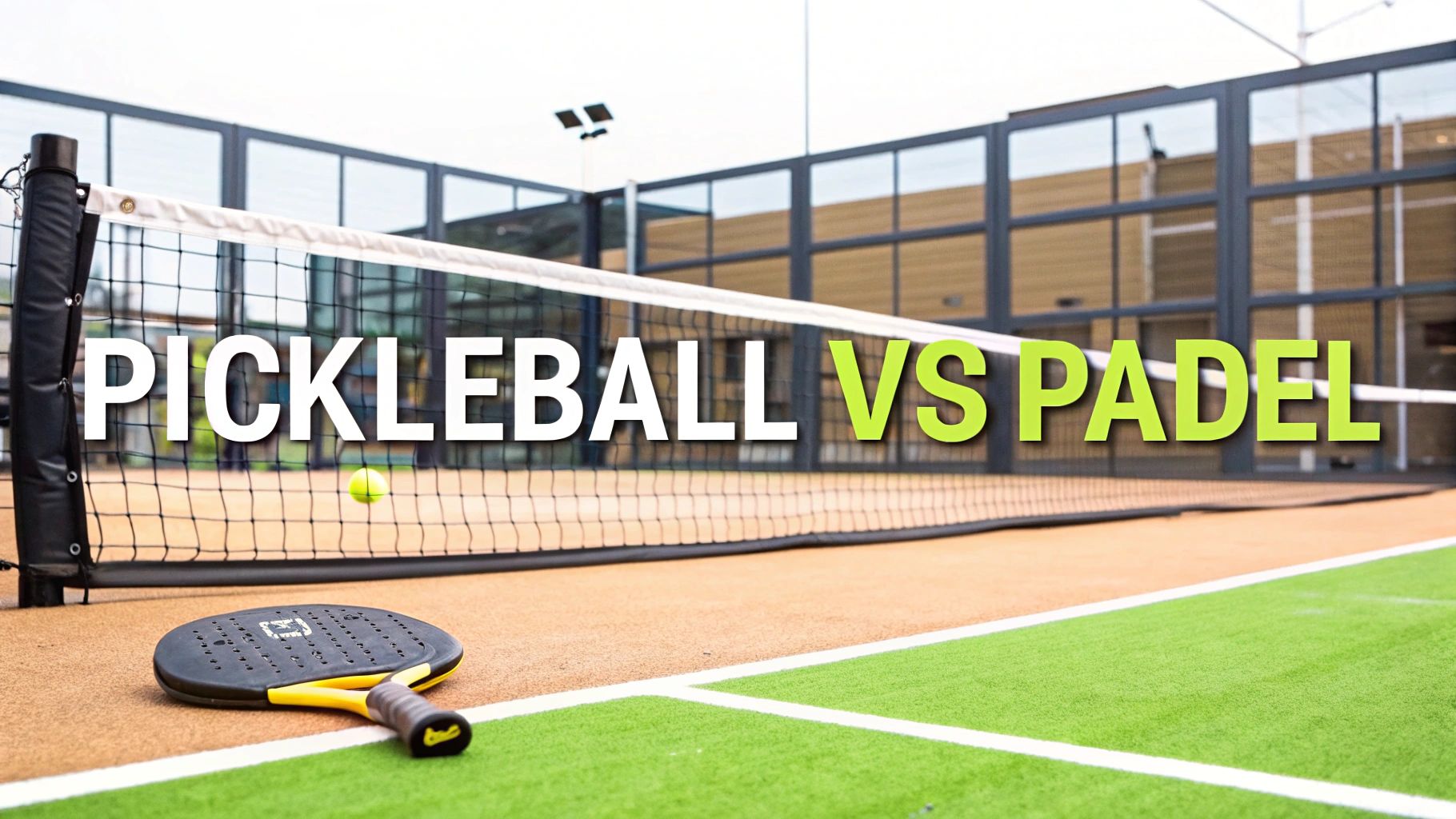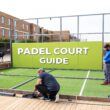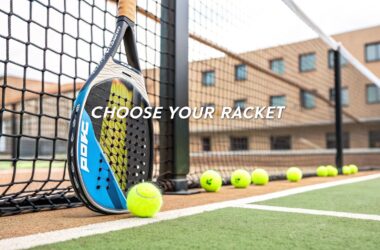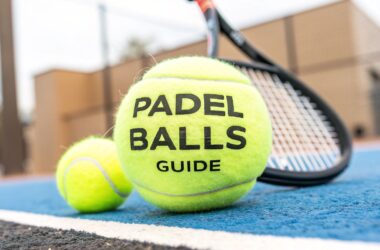Thinking about jumping into a new racket sport? Two names you’ll hear everywhere right now are pickleball and padel. At first glance, they might seem similar, but once you step onto the court, you’ll find two completely different games.
Your choice really boils down to what you're looking for. Pickleball offers a super accessible, social game that's easy to pick up, played on a compact court. Padel, on the other hand, delivers a faster-paced, more tactical doubles match where you use glass walls to keep the rallies alive. It’s all about whether you want some easy-to-learn fun or a high-energy, strategic challenge.
A Quick Look at Two Exploding Racket Sports
Pickleball and padel are hands down two of the fastest-growing sports on the planet, grabbing players with their unique mix of social fun and athletic gameplay. While people often mix them up, they offer distinct experiences shaped by their specific rules, gear, and court designs.
A huge part of their appeal is that both are generally easier to learn than tennis, making them fantastic for newcomers. But don't let that fool you—they both have enough strategic depth to keep experienced players hooked for years.
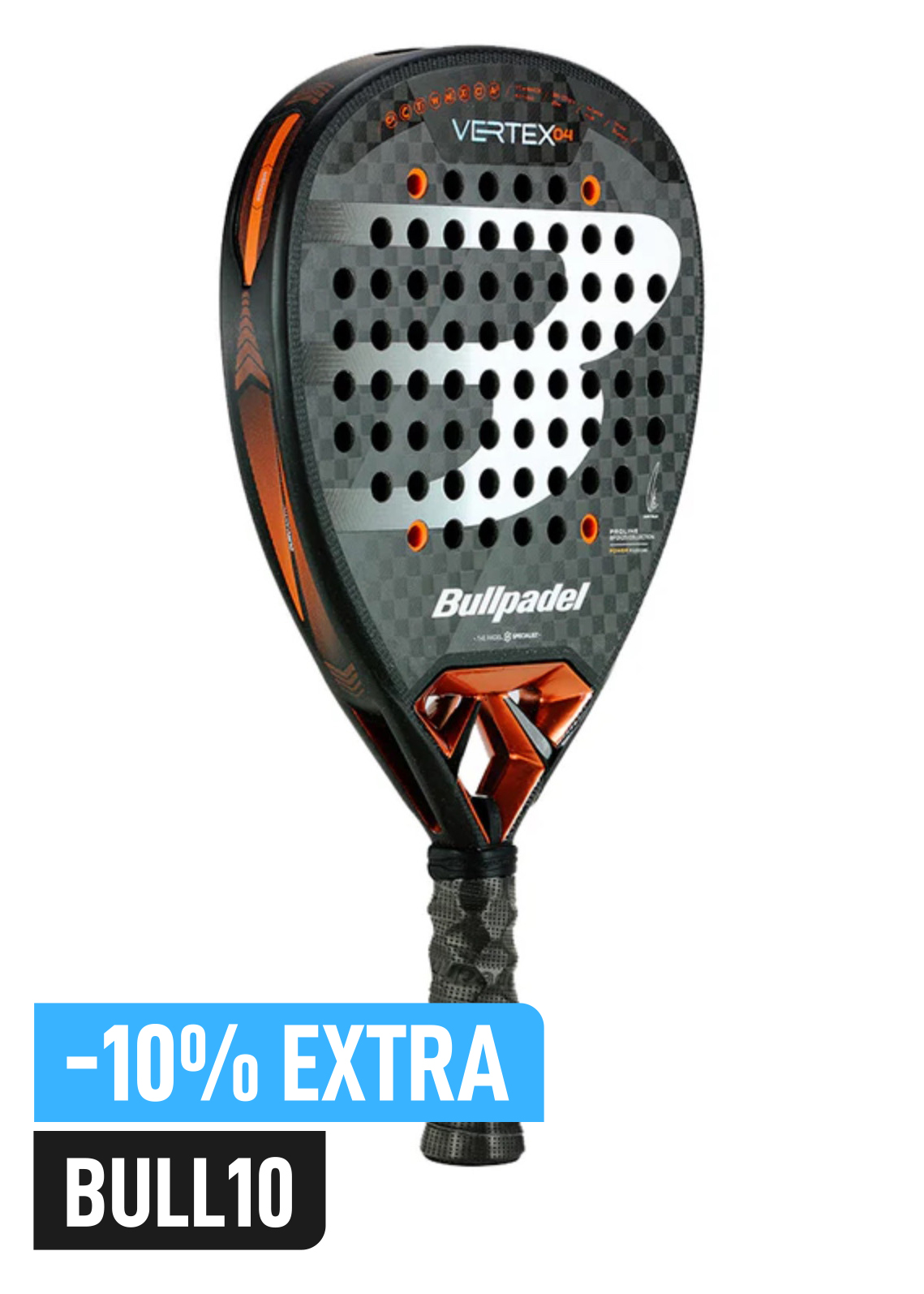
Buy the best padel gear to level up your next game!
CHECK OUT this deal from Padel Market!Get ready to take your game to the next level with the latest padel gear from Padel Market! Fast EU and Worldwide Shipping
Looking at their growth, you see two different stories. Padel is a global powerhouse, with around 30 million players worldwide and a market projected to hit nearly $500 million by 2032. Its popularity is deeply rooted in Europe and Latin America. Pickleball, for now, is mostly a North American sensation, but it's catching fire and expanding globally at a rapid pace.
Key Differences at a Glance
The infographic below really nails the core differences in court size, paddles, and whether you're playing singles or doubles.
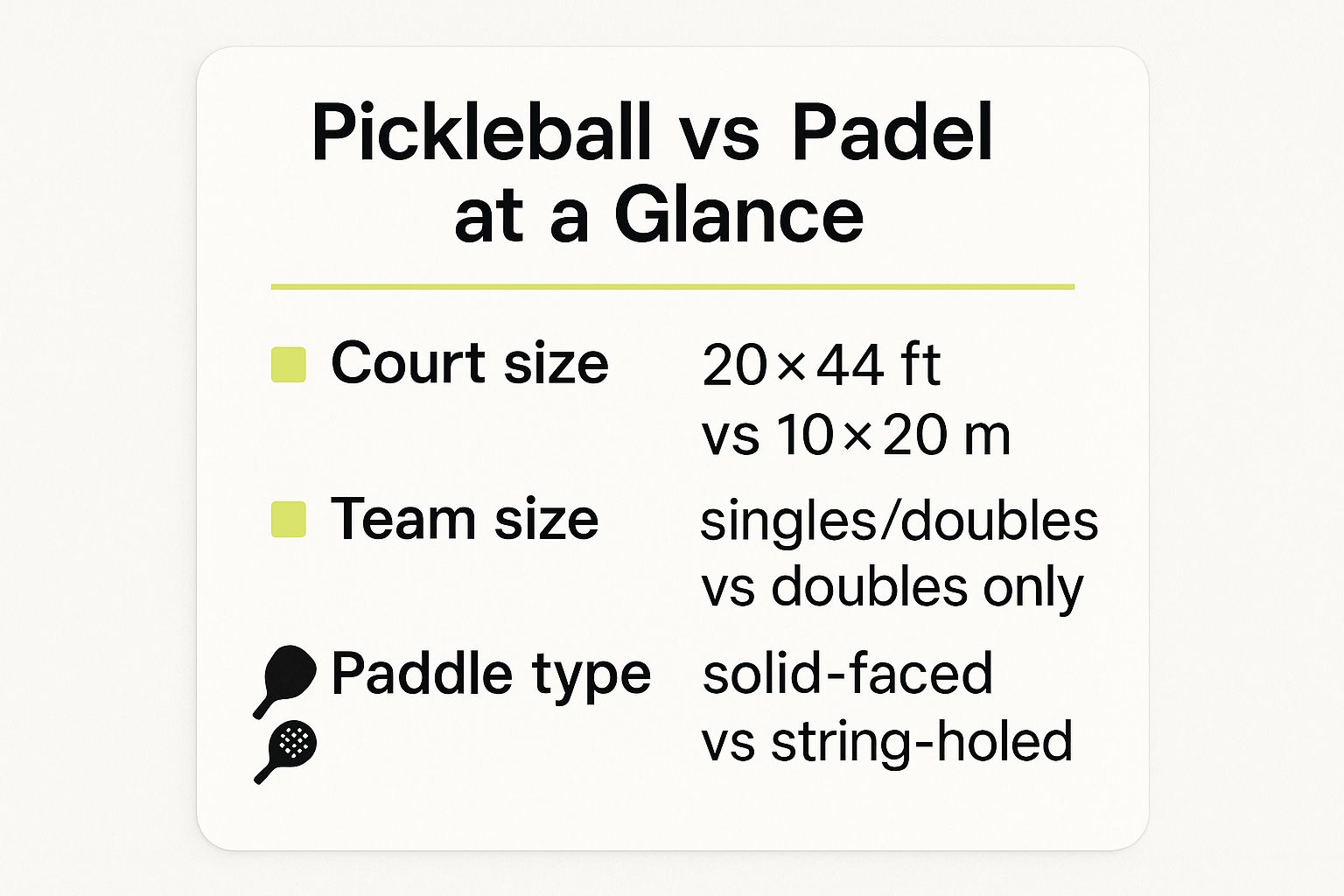
This visual shows you right away how padel's larger, enclosed court and doubles-only format create a totally different game than what you see on a pickleball court. Padel is all about using angles and rebounds off the walls, which demands teamwork and a smart, tactical approach. To get a better feel for how these elements work together, check out this great breakdown of what is padel.
To give you an even clearer picture before we dive deep, here’s a quick side-by-side comparison of the two sports.
Pickleball vs Padel At a Glance
This table breaks down the essentials, making it easy to see how the sports stack up against each other.
| Feature | Pickleball | Padel |
|---|---|---|
| Court Size | 13.4m x 6.1m (44ft x 20ft) | 20m x 10m (66ft x 33ft) |
| Court Walls | None (Open court) | Enclosed by glass & mesh |
| Ball Type | Plastic wiffle ball (slower) | Depressurized tennis ball |
| Paddle/Racket | Solid face, no holes | Perforated, thicker core |
| Dominant Play | Doubles and singles | Almost exclusively doubles |
| Serving Style | Underhand serve | Underhand bounce-serve |
As you can see, from the court to the equipment, these sports are built for different experiences. Now, let’s get into the nitty-gritty of what separates them.
Comparing The Court and Required Gear
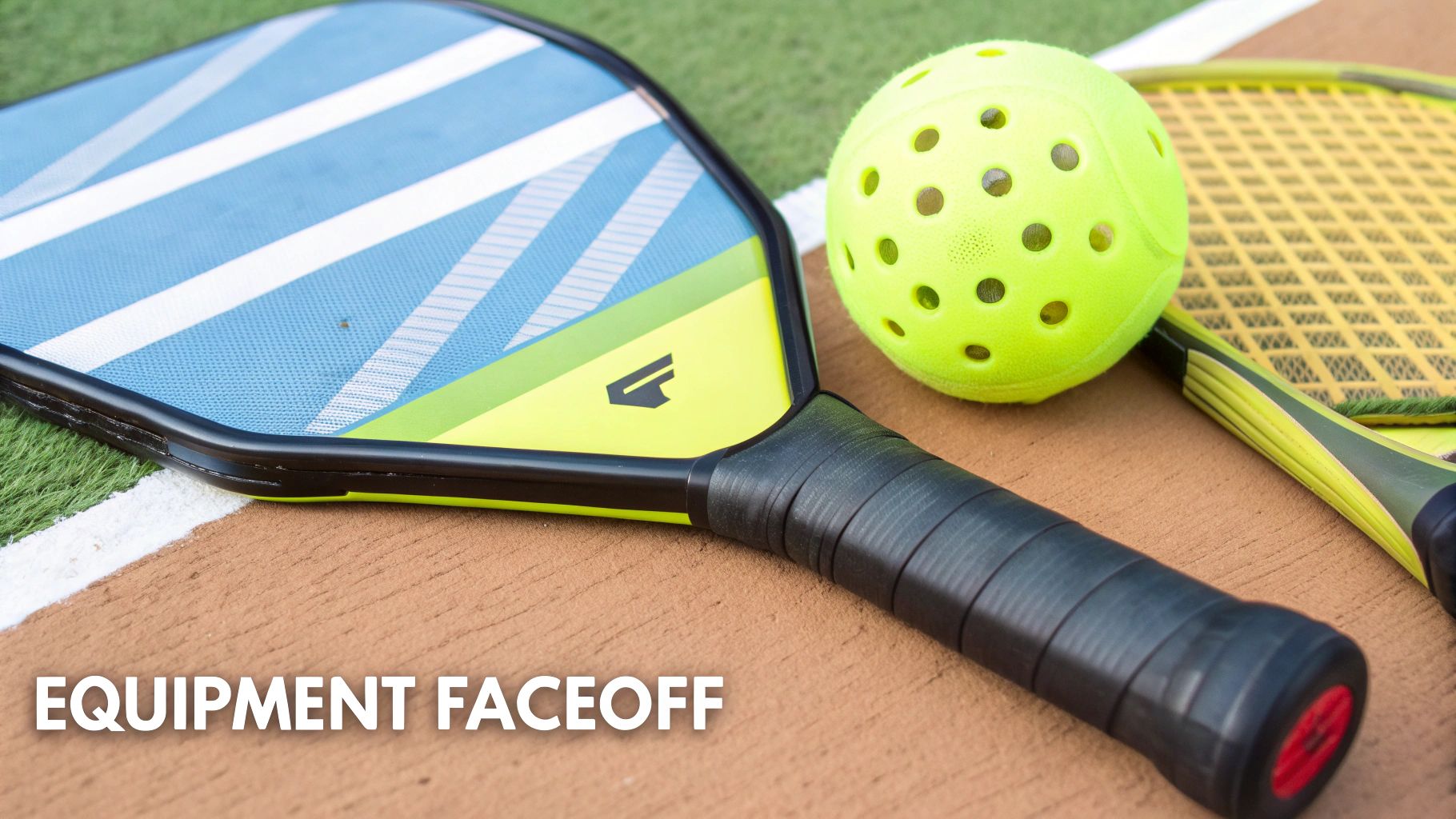
This is where the pickleball vs. padel distinction really comes alive. The court and the equipment aren't just superficial differences; they fundamentally shape the strategy, feel, and flow of every single point. One sport gives you an open field of play, while the other literally walls you in.
A pickleball court is simple and direct. It measures 13.4m x 6.1m (44ft x 20ft), sharing the exact dimensions of a badminton court. With no walls to speak of, a ball hit out of bounds is exactly that—out. This wide-open design forces players to master precise shot placement and control the action at the net.
Padel, on the other hand, is played inside a rectangular cage measuring 20m x 10m (66ft x 33ft). This court is fully enclosed by glass and mesh walls that are an active part of the game, creating a dynamic, 360-degree playing experience. If you're curious about the nitty-gritty, you can dive deeper into the specifics of padel court construction and dimensions.
The Paddles and Rackets
The tools you play with also tell a huge part of the story. A pickleball paddle is a solid, stringless paddle, usually made from composite materials like graphite. It’s lightweight with a totally flat face, built for control and a delicate touch—especially for those soft dink shots right at the net.
Padel rackets are also stringless, but they are noticeably thicker and heavier, and they have a perforated face. Those holes aren't just for looks; they cut down on air resistance and help you whip the racket through the air for powerful, spin-heavy shots. The core is often a soft foam or rubber, giving it a unique feel that's a world away from a pickleball paddle.
Key Insight: The core difference really boils down to intent. Pickleball paddles are built for finesse and placement in an open area. Padel rackets are engineered for raw power, heavy spin, and using the walls to your advantage inside an enclosure.
How the Ball Dictates Play
Finally, let's talk about the ball. This is probably the most underrated factor when comparing the two sports, but it dictates the entire pace and rhythm of the game.
- Pickleball Ball: This is a hard plastic ball riddled with holes, a lot like a wiffle ball. It moves much slower through the air and has a low, very predictable bounce. This is what encourages those long, patient rallies built on strategy and placement.
- Padel Ball: A padel ball looks just like a tennis ball but it’s slightly smaller and has less internal pressure. This design creates a much livelier bounce off the court surface and a dynamic, explosive rebound off the glass walls, leading to fast-paced, aggressive exchanges.
This small detail has a massive impact on gameplay. The slower pickleball promotes a controlled, tactical chess match, while the bouncier padel ball rewards lightning-fast reflexes and the creative use of wall angles.

Buy the best padel gear to level up your next game!
CHECK OUT this deal from Padel Market!Get ready to take your game to the next level with the latest padel gear from Padel Market! Fast EU and Worldwide Shipping
How the Rules Shape the On-Court Experience
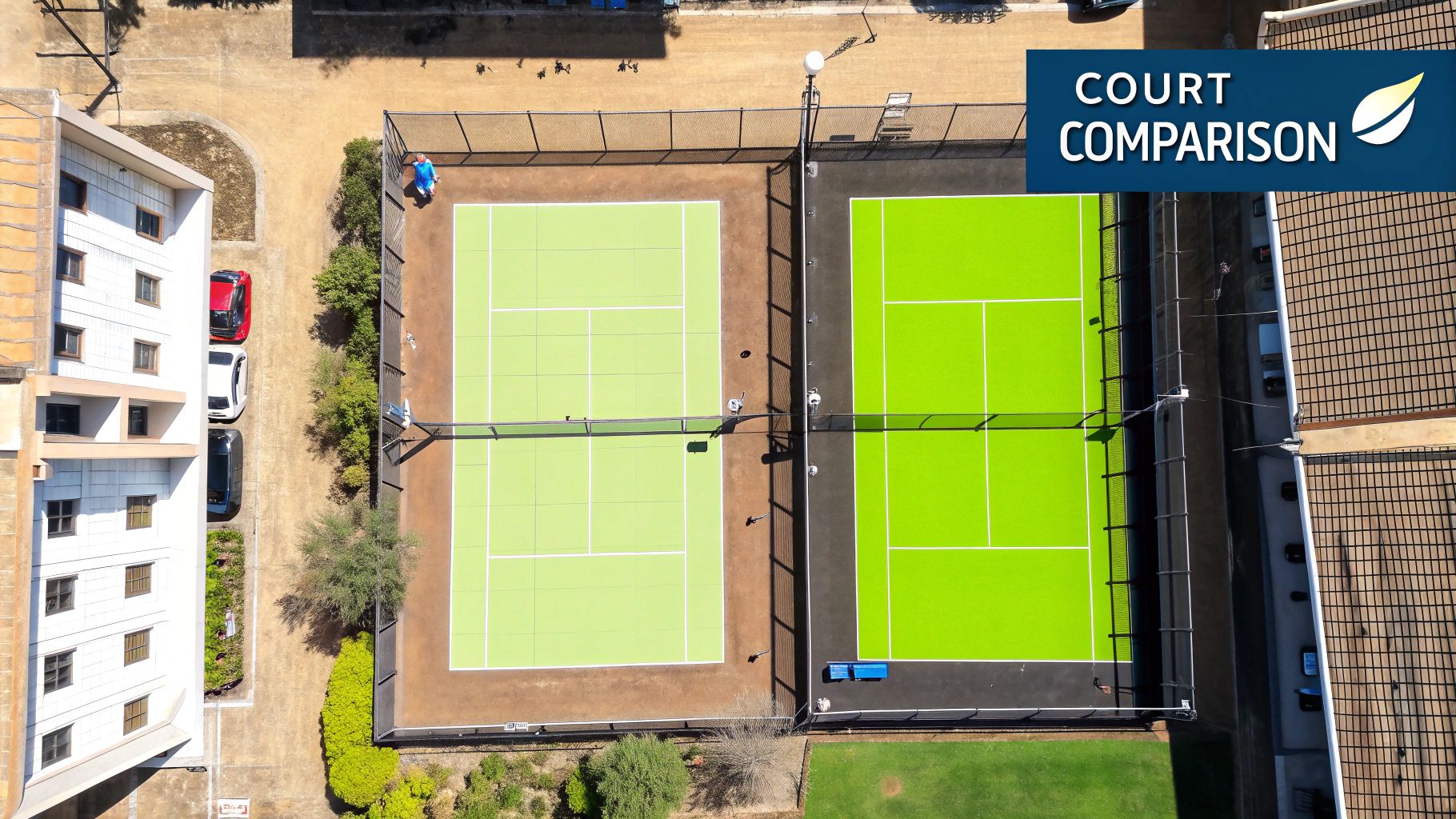
While the courts and gear certainly set the stage, it's the rules that truly direct the performance. The regulations in pickleball and padel dictate the entire rhythm of the game, creating two vastly different strategic mindsets and on-court battles. Getting a handle on these core differences is key to figuring out which sport fits your style.
Pickleball’s rulebook is built around one central idea: fostering long, strategic rallies that reward placement over raw power. The two biggest rules driving this are the underhand serve and the non-volley zone, famously known as "the kitchen."
You have to serve underhand, making contact with the ball below your waist. This immediately neuters the kind of powerful, ace-driven serves you see in tennis and makes the return of serve a much more manageable part of the game for players of all skill levels.
The Pickleball Kitchen and Dinking
The most unique, and arguably most important, rule in pickleball is the seven-foot non-volley zone on each side of the net. Players are flat-out forbidden from hitting the ball out of the air (a volley) while standing inside this area. This one simple rule is the absolute heart of pickleball strategy.
It completely prevents players from camping at the net and smashing every shot that comes their way. Instead, it forces them into a delicate, strategic game of "dinking"—hitting soft, controlled shots that arc just over the net and land in the opponent's kitchen. This tactical exchange often feels more like a chess match than a power sport.
Situational Mindset: The kitchen creates a game of patience. A great pickleball player masters the soft game, waiting for the perfect moment—usually an opponent's unforced error—to put away a winner. It’s a sport that rewards control, precision, and tactical thinking far more than brute strength.
Padel and Its Dynamic Walls
Padel, on the other hand, brings a game-changing element into the mix: the walls. While the serve is also underhand, it must first bounce on the server's side before being struck cross-court into the opponent’s service box. This type of serve is generally pretty easy to execute and return, even more so than in pickleball.
But the real strategic genius of padel comes from its signature rule: the ball is still in play after it bounces off the glass walls. This completely flips the game's geometry and pace on its head. A shot that would be "out" in any other racket sport is suddenly a live ball, leading to incredibly long rallies and wild strategic options.
This rule demands a totally different kind of court awareness. Here’s how it usually plays out:
- Defensive Returns: You can let a hard-hit ball fly past you, wait for it to ricochet off the back wall, and then calmly return it. This turns a seemingly lost point into a genuine offensive opportunity.
- Offensive Angles: Skilled players will intentionally use the side walls to create nasty angles, sending the ball in unexpected directions that pull their opponents way out of position.
Using the walls makes padel a fast-paced, 360-degree contest that’s all about quick reflexes, constant movement, and tight teamwork. You aren't just battling your opponents across the net; you're also fighting the angles and rebounds created by the enclosure itself. In the pickleball vs. padel matchup, this is probably the single biggest difference in how the games are played.
Sure, here is the rewritten section, crafted to sound completely human-written and match the provided blog post examples.
Where Each Sport Is Played and Who Is Playing
A sport's real identity comes from its community. Beyond the rules and equipment, the culture and people on the court are what truly define the experience. When you look at pickleball versus padel, you see two completely different stories in terms of their global footprint and player demographics.
Pickleball is, through and through, an American success story. Its growth has been nothing short of explosive across the United States, with local parks and old tennis courts getting a new lease on life as pickleball hubs. The sport's magic lies in its wide appeal. You'll see retirees enjoying a friendly match right next to hyper-competitive young adults, all sharing the same court.
This welcoming, open vibe is one of pickleball’s biggest draws. Many public courts run on a simple drop-in system. You just show up, put your paddle in a line, and rotate into games with new people. It’s a fantastic way to meet people and get playing without any fuss.
Padel's Global Dominance
Padel, on the other hand, tells an international tale. Its roots are deeply embedded in Europe and Latin America, where it's less of a public park game and more of a club-based social event. This club culture has cemented its status as a premier athletic and social activity in dozens of countries.
Padel's popularity is highly concentrated in specific regions. Europe is its fortress, with roughly 59% of the world's players. Spain is the undisputed king, with somewhere between 5 and 5.5 million players—it’s practically a national pastime there. Italy and Sweden aren't far behind, and in Latin America, countries like Argentina and Mexico boast millions of their own enthusiasts. To really grasp its reach, you can discover more global padel statistics.
Key Takeaway: Pickleball thrives on grassroots, community-driven energy in the U.S., making it incredibly accessible. Padel is a more established, club-focused sport with a massive international following, particularly popular among former tennis players looking for a high-energy social scene.
Who Is on the Court
The typical player profile for each sport also tells a different story. While pickleball is now attracting all ages, its initial explosion was fueled by the 55+ crowd. That’s changing fast as younger athletes discover the game, but it remains a perfect family activity and an easy entry point for anyone new to racket sports.
Padel generally pulls in a slightly younger, more athletic crowd, especially those coming from a tennis background. The skills just translate so well—powerful smashes, quick volleys, and smart positioning are all key. Players love its intensity and the complex, team-based strategies that the glass-walled court brings into play.
This is where the choice between pickleball vs padel becomes clear: are you looking for a game that anyone can pick up and play, or do you want a dynamic, athletic challenge with deep strategic layers?
Comparing Your Investment of Time and Money
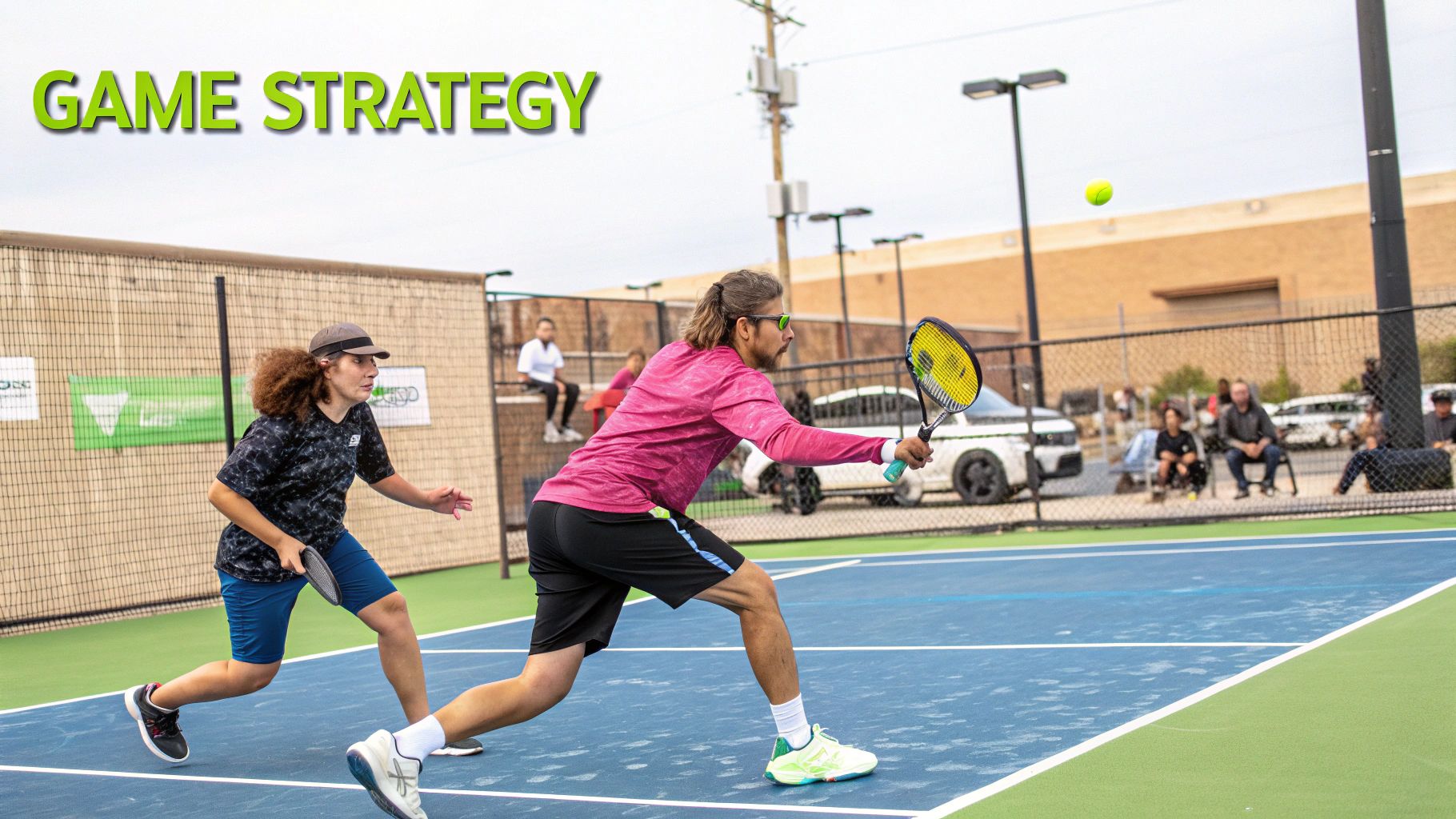
When you're trying to pick between pickleball and padel, the practical side of things—money and time—often makes the decision for you. Both sports need some upfront cash for gear and a place to play, but how that investment breaks down is pretty different. Your budget and how fast you want to get into the action will really point you in the right direction.
Pickleball is famous for being incredibly easy to get into, both financially and skill-wise. The initial cost to start playing is quite low, which is a huge draw for individuals, families, and anyone just looking for a casual weekend game.
Padel, on the other hand, usually requires a bit more of an investment from the get-go. This is mainly because the courts are more specialized and are almost always located in private clubs, which comes with its own set of costs.
Breaking Down the Costs
Let’s get into the nitty-gritty of what you can expect to spend to get started in either sport. Seeing the numbers side-by-side should give you a clearer picture before you dive in.
Pickleball Startup Costs:
- Paddles: You can get a solid beginner pickleball paddle for about $50 to $100.
- Balls: A pack of pickleballs is cheap, typically running you $10 to $15.
- Court Time: Here’s pickleball’s trump card. Thousands of public parks across the U.S. have courts you can use for free, which dramatically cuts down the long-term cost of playing.
Padel Startup Costs:
- Rackets: An entry-level padel racket is a bit pricier, starting around $75 to $150.
- Balls: Padel balls are priced similarly to tennis balls, usually $5 to $10 for a can of three.
- Court Time: This is the big one. Padel courts are almost exclusively found in private clubs. You’ll be paying for court rentals, which can be anywhere from $20 to $50+ per hour, or buying a club membership.
The Verdict on Cost: If you're on a budget or just want a sport without a lot of recurring costs, pickleball is the clear winner. The sheer number of free public courts makes it incredibly affordable to play on a regular basis. Padel is a club sport at its core, and that means you're looking at memberships or regular rental fees.
The Learning Curve and Time Commitment
Money isn't the only thing you invest; your time is just as valuable. So, how long does it take before you can actually play the game and have a good time?
Pickleball is legendary for its gentle learning curve. It's not an exaggeration to say that total beginners can hold a rally within their first 15-20 minutes on the court. The small court, underhand serve, and slower ball make it super accessible, and the simple rules mean you can jump into a real game almost immediately.
Padel is a bit more of a challenge, mostly because of the glass walls. Getting your positioning right and learning how to play shots off the rebound takes real practice. While you can pick up the basics fairly easily, becoming truly proficient and mastering the strategic element of wall-play demands a much bigger time investment.
The business side of padel's growth reinforces this club-based model. Think about it: you can convert a single tennis court into three padel courts, which can host 12 players instead of just two. This smart use of space makes more money for clubs, which in turn fuels the sport's expansion, a topic covered well in this insightful article on the sports' growth. It all feeds back into the pay-to-play system that defines the padel experience.
Making Your Choice Between Pickleball and Padel
So, how do you decide between pickleball and padel? It really boils down to what you’re looking for in a sport. Your own athletic background, what you want out of the social side of things, and even how competitive you are will all steer you toward the right court. This isn't about which sport is "better" in a vacuum, but which one is a better fit for you.
The choice gets a lot simpler when you start thinking about specific situations. Are you an ex-tennis player hungry for a new competitive outlet, or maybe a family just looking for a fun new activity you can all do together? Let's walk through some practical scenarios to help you make your pick.
Who Should Choose Pickleball
Pickleball is probably your best bet if you're chasing immediate fun and a lively social atmosphere. The learning curve is incredibly gentle—honestly, you can be having solid, enjoyable rallies just minutes after stepping onto the court for the first time. This makes it a fantastic option for a huge range of people.
Give pickleball a serious look if you are:
- A Total Beginner or a Family: The rules are straightforward and the ball moves slower, making it super accessible for all ages and fitness levels.
- Looking to Meet People: The drop-in culture at public parks is huge. It’s easy to show up, find a game, and connect with new people without any formal planning.
- Watching Your Budget: With a massive number of free public courts, the ongoing cost to play is significantly lower than most racket sports.
The Verdict: Choose pickleball for its incredibly low barrier to entry, super social vibe, and its focus on strategy over brute strength. It's a game of finesse—all about dinks, drop shots, and smart placement.
Who Should Choose Padel
Padel is the clear winner if you crave fast-paced, athletic action that has a deep layer of strategy. It’s a natural fit for players who love the intensity of doubles and get excited by the unique challenge of playing balls off the glass walls. This is where old tennis instincts can really come alive. For a deeper dive, this guide takes a closer look at the padel vs pickleball comparison.
Padel is likely for you if you are:
- A Former Tennis Player: Your volleys, smashes, and general court sense will give you a massive head start. The skills translate beautifully to padel’s dynamic rallies.
- A Fan of Intense Teamwork: Padel is almost always played as doubles, so it demands constant communication and moving in sync with your partner.
- Someone Who Enjoys a Club Vibe: If you like the community, amenities, and structured environment of a private sports club, padel’s club-centric world will feel perfect.
Frequently Asked Questions
As the pickleball vs. padel debate gets louder, a few common questions always seem to pop up. Whether you're coming from another racquet sport or picking up a paddle for the very first time, it's totally normal to have some questions. Let's clear things up so you can figure out which game is the right fit for you.
Is Padel Harder to Learn Than Pickleball?
For a complete beginner, pickleball is almost always easier to pick up. The court is smaller, the plastic ball moves slower, and the rules are pretty straightforward. Most people can get a rally going within minutes.
Padel, on the other hand, has a slightly steeper learning curve. The biggest hurdle is getting the hang of using the glass walls. It’s not just about hitting the ball back; it's about strategically using the rebound, which takes real time and practice to master.
How Do Tennis Skills Transfer to These Sports?
Having a tennis background gives you a major leg up, but how those skills apply is quite different for each sport.
- For Padel: Your tennis instincts will serve you well. Powerful smashes, quick net volleys, and a good sense of court positioning translate almost directly. The speed and strategic feel of the game will seem very familiar.
- For Pickleball: While your hand-eye coordination is a plus, many tennis players have to unlearn their big, powerful groundstrokes. Pickleball is all about the soft game—developing a controlled "dinking" strategy near the net is absolutely essential.
Key Insight: Both sports are incredibly social, but the way their communities are built is a key difference. Pickleball's drop-in, open-play format at public parks makes it unbelievably easy to just show up and meet new players. Padel is almost always played as doubles and its community is often built around a private club, leading to strong, tight-knit groups of players. For many, this social dynamic is the real deciding factor.


